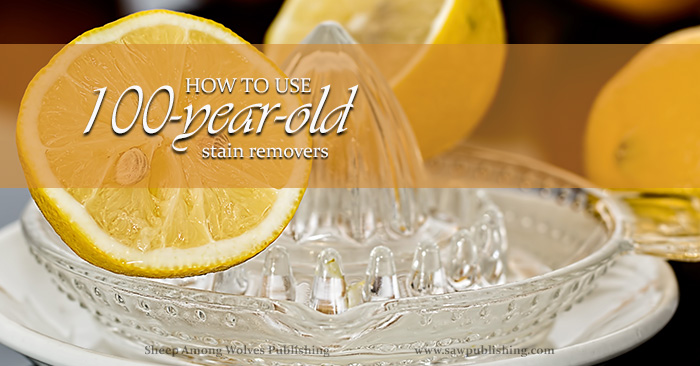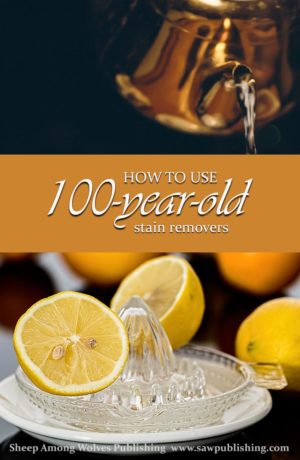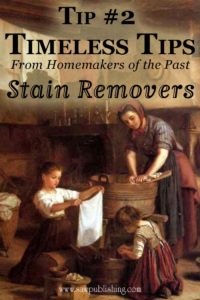How To Use 100-Year-Old Stain Removers – Timeless Tip #2
Timeless Tips from Homemakers of the Past is an ongoing series highlighting useful and thought provoking tidbits from the generations of homemakers who have gone before us. Our goal at Sheep Among Wolves is to provide a forum for Good and Great literature, and to help you in your quest for godly, high-quality resources. It is our hope that these Timeless Tips will be an aid and encouragement to you as you strive to follow the example of Titus 2, and become a keeper of the home.

Something delightful happened to me yesterday. I splattered orange juice on my shirt.
Yes, the previous paragraph sounds a little like those unrelated sentences you get in grammar programs, where you are supposed to circle the noun, divide the subject from the predicate, etc. But the reason I was so pleased about the orange juice was that I had been working on stain removal posts for the past two days. The timing was perfect.
And now for my bottle of 100-year old-stain remover . . .
Well, not quite. I recently came across a fascinating chapter in an old housekeeping book. A Manual of Home-Making was published in 1920, and it devotes a whole chapter to stain removal. Some of the techniques are still familiar today. Others (like the raw potato), have grown fairly obsolete. And for the most universal “stain remover” of all, this book gives some helpful hints about when to use hot water—and when to use cold.
Removing Mud Stains
- Let Them Dry! “Allow mud stains to dry and brush carefully before any other treatment is used. Sometimes no other treatment is necessary.”
- Soap and Water “As is ordinary laundering, for washable materials.”
- Rubbing Alcohol “Sponge the stains with [rubbing] alcohol.”
- Cut Raw Potato This one is only good for black silk, but it’s so original that I had to include it. If you are so fortunate as to have something made of black silk that got mud on it, please try this out, and let me know how it worked in the comments section below!
“For black silks of firm weave, after brushing, rub the spot with the potato. This leaves a thin film of starch on the surface of the cloth, which can be brushed off when dry. This treatment is too harsh for any but rather smooth, firm goods, and leaves a spot on all but black material.”
Removing Fruit Stains
 Treat Them While They’re Fresh
Treat Them While They’re Fresh
“Practically all fruit stains, when they are fresh and still moist, can be removed with boiling or even warm water. After they have dried they become much more difficult to remove.”
- Hot or Boiling Water “Stretch the stained material over a bowl or other vessel, holding it by a string or an elastic band, if necessary, and pour boiling water upon it from a teakettle held at a height of 3 or 4 feet so that the water strikes the stain with some force.”
Of course, you need a place to be able to do this with without spraying water everywhere. In the instance of the orange juice I mentioned above, I was able to remove it from my blouse by putting it—dish, elastic band, and all—in the sink and running the tap water as hot as it would go. The bowl, I believe, is necessary just so you don’t burn your fingers.
“With some stains, especially those in which fruit pulp was present, a little rubbing alternated with applications of boiling water is helpful. A stain remaining after this treatment frequently can be bleached by hanging the wet material in the sun to dry.”
- Lemon Juice or Oxalic Acid “Stains remaining after treatment with boiling water can often be bleached by moistening with lemon juice and exposing to the bright sunlight. . . . A stain which turns blue or gray and cannot be removed readily by boiling water sometimes can be loosened by moistening with a little acid, which restores its original color and renders it more easily soluble in the boiling water. If necessary, apply the acid several times, alternating with boiling water.”
- Javelle Water Also known as Sodium Hypochlorite, this is a bleach which may be used on some materials, provided they do not contain wool or silk. A Manual of Home-Making warns against using it on any but white clothes, although it is today considered safe for colour-fast fabrics. “The Javelle water should not be allowed to remain in contact with the stain for more than one minute and then oxalic-acid solution should be applied to neutralize the Javelle water and the stain rinsed by dipping in the bowl of water.” Clorox or Javex are two North American substitutes for Javelle water.
- Hydrogen Peroxide “Stains remaining on silk and wool (white or fast color) after sponging with warm water frequently can be removed with a little hydrogen peroxide.”
Removing Cooked Fruit Stains
“In many cases changes in cooking render the stains from cooked fruit much easier to remove than those of fresh fruit. In fact, they often are removed from a fabric by ordinary laundering. Stains from some cooked fruits, however, especially the dark red and purple fruits and berries, such as cranberries and black raspberries, are similar to the fresh fruit stains in being set by alkaline substances.”
- Hot or Boiling Water Follow the same instructions as for fresh fruit.
- Soap and Water “(Ordinary laundering.) This does not apply to the dark-colored (red or purple) fruits and berries. Treat them in the same way as fresh fruit.”
Please note that this is for light-coloured, cooked fruits. In another part of the chapter the author warns that soap is capable of “setting” some fruit stains, instead of removing them.
Removing Blood Stains
- Cold or Lukewarm Water “Either soak the blood stains or rub them in the water until they turn light brown in color; that is, until most of the coloring matter is dissolved. Then wash the material in hot water, as in the ordinary process of laundering. For stains on silk or wool, sponge in cold or lukewarm water.”
- Soap (for washable materials) “Rub the stained portions with soap and place in cold water, either allowing them to stand in it until the stains are loosened or bring the water very slowly to the boiling point.” (Obviously, this last is better suited to historic laundry methods, than to our modern washing machines.)
- Ammonia (for washable materials) “Use about 1 ounce (2 tablespoons) of household ammonia to 1 gallon of water. Soak the stains in this until they are loosened and then wash in the usual manner. For old stains ammonia is somewhat more satisfactory than soap.”
- Hydrogen Peroxide “Sponging with a little hydrogen peroxide often will remove the last traces of blood stains after the main part has been removed as described in No. 1 above. This agent can be used on wool and silk, provided it does not injure the color of the material.”
Hydrogen Peroxide is safe for white and colour-fast fabrics. Non colour-fast fabrics are bleached by it.
- Starch “Raw starch mixed with cold water to a paste is efficient for stains on thick materials, such as flannel and blankets, which cannot conveniently be soaked in water. Apply the paste thickly to the stain, and brush it away when it becomes dry. Repeat the application until the stain is removed.” Cornstarch works well here.
Homemade Wisdom from 100-Year-Old Stain Removers
It’s neat to think that some stain removers really don’t have a “best before” date! It is true that modern science has changed many elements of stain removal, and laundry in general. But there are always some Timeless Tips that hold true today.
In this post I’ve only had time to highlight a few common stains, and how to remove them. Join us next week for a glimpse into the science behind stain removers, as well as some pointers for choosing chemicals that are safe for your fabric.
And as always, whether you have tried the potato thing or not, we would love to hear your stain removal tips in the comments section below.
You might also enjoy:
Unless otherwise referenced, the quotations in this article were taken from A Manual of Home-Making by Martha Van Rensselaer, et al., who had in turn reprinted a significant part of their stain removal chapter from Farmers’ Bull. 861, Removal of Stains from Clothing and Other Textiles by Harold L. Lang and Anna H. Whittelsey of the U.S. Dept. of Agriculture.

This post has been shared on The Art of Homemaking Mondays linkup.
- How To Choose Toys That Will Change Your Child’s Life – Timeless Tip #1
- Are You Looking For Safe Stain Removers? – Timeless Tip #3




Excellent! Pinned it!